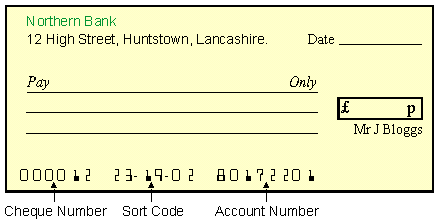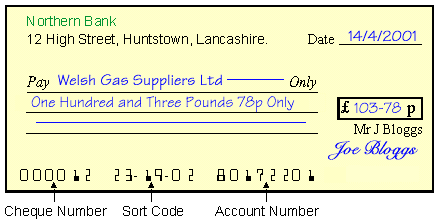| | Banking : Cheques |
|
Before the invention of debit and credit cards anyone who wished to pay for an item without using cash had to use a cheque. Cheques can still be used to pay for goods and are often used when payment must be made by post.
The Information on a Cheque
A bank customer is issued with a cheque book which typically contains 25 cheques. Each cheque looks like this :

Some information is printed on the bottom of each cheque using a special magnetic ink. This can be read by a human and also by a computer using Magnetic Ink Character Recognition. The printed information is :
1.
| A cheque number which uniquely identifies the cheque.
| 2.
| A sort code which identifies which bank and which branch the cheque comes from.
| 3.
| An account number to identify which bank account money should be taken out of when the
cheque is used.
| |
Using a Cheque
To pay for an item by cheque a bank customer must fill in the blank spaces on the cheque and sign it. This cheque has been completed :

The customer has written this information onto the cheque using a pen :
1.
| The name of the company that the payment is to.
| 2.
| The date that the payment is being made on.
| 3.
| The amount of money to be paid, which is written in both words and figures.
| |
Writing the amount out twice reduces the likelihood that the customer will accidentally write the wrong amount. It also makes it harder for someone else to change the amount later on. The bank will use the signature to verify that the cheque has been filled in by the authorised customer and is not a forgery.
When the cheque is completed the customer will hand it or post it to the person that he has purchased items from. This person will then send the cheque to the bank so that payment can be made. The payment will not be made until the bank has received and cleared the cheque.
Clearing is the process used by a bank to verify that cheques are genuine and to transfer the money from the bank account of the person who wrote the cheque out to the bank account of the person that the cheque is made payable to. This is how the clearing process works :
1.
| The person who has received payment by cheque takes the cheque to his bank and tells
the bank the account number of the account that the money should be paid into.
| 2.
| The signature on the cheque is compared to the signature that the bank has on record for
the customer to verify that the cheque is genuine.
| 3.
| The amount of the cheque is read by a human operator and typed onto the cheque in magentic
characters so that the rest of the clearing process can be completely automated.
| 4.
| Batches of cheques are then fed into an automated
MICR reader which can process around 3000 cheques per
minute.
| 5.
| The computer checks that the person who made the cheque out has enough money in his bank account
to pay the amount written on the cheque. If he does not have enough money then the
cheque is rejected.
| 6.
| The amount written on the cheque is transferred from the account of the person who
wrote the cheque to the account of the person who received the cheque.
| 7.
| Finally the cheque is stored so that it can be retrieved later if there is any query
about the payment.
| |
The clearing process is quite complicated and can take up to seven days to complete. This means that someone who has been paid by cheque may have to wait for a whole week until the payment is actually received. If the person who wrote out the cheque does not have enough money to make the payment then it can be very difficult for the person who received it to obtain the money.
Advantages and Disadvantages of Using Cheques
| For People Paying By Cheque | For People Receiving Payment by Cheque | ||||
| Advantages |
|
For most purposes it is usually better to pay by debit or credit card than by cheque.
GCSE ICT Companion 04 - (C) P Meakin 2004